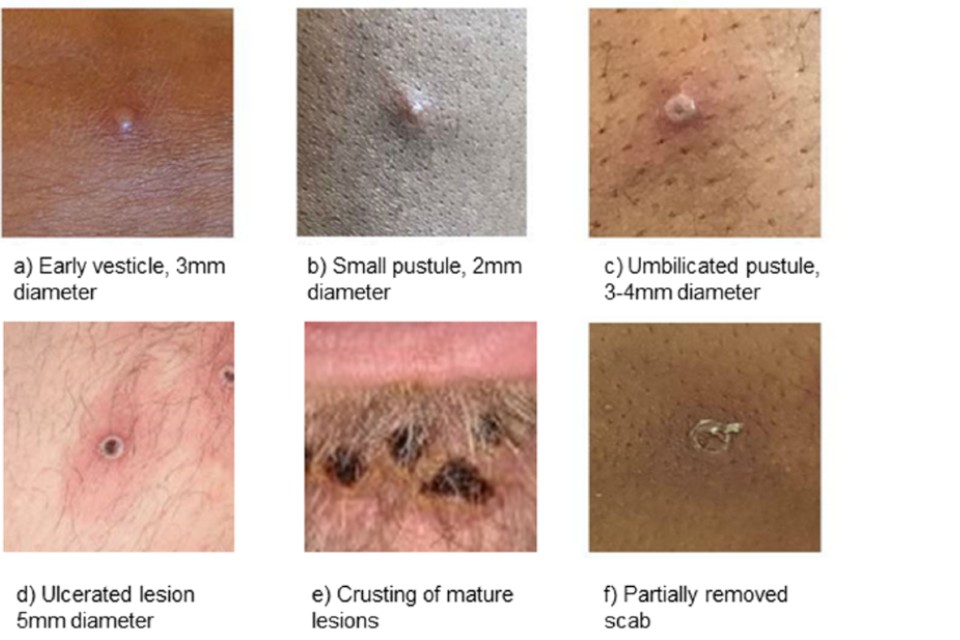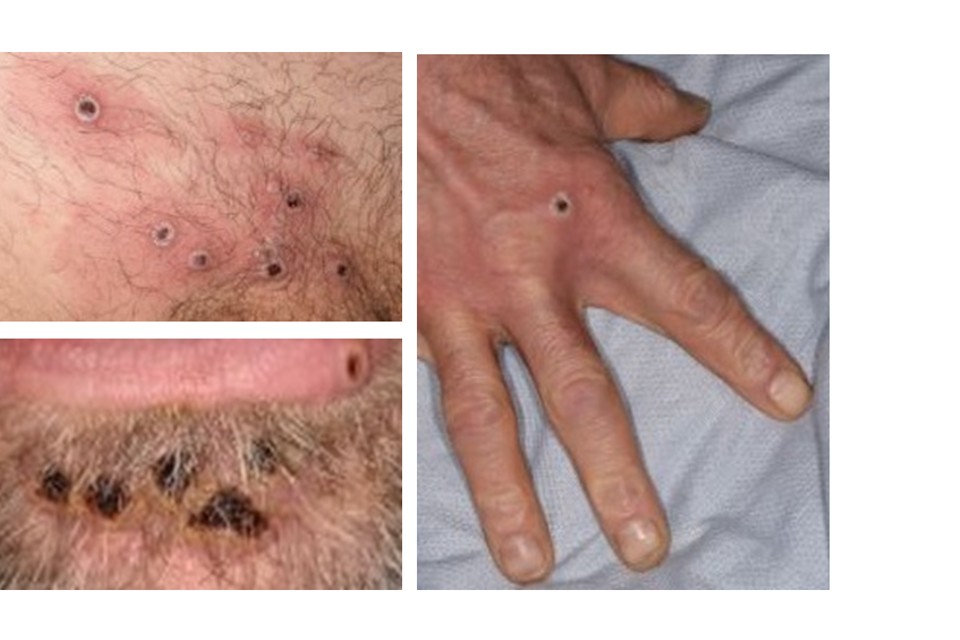Mpox: background information
The epidemiology, symptoms, diagnosis and management of monkeypox virus infections.
See the mpox collection page for further resources including guidance for health professionals.
Epidemiology
Mpox is an infectious disease that is caused by infection with a virus called MPXV. Mpox was first discovered in 1958 when outbreaks of a pox-like disease occurred in monkeys kept for research. The first human case was recorded in 1970 in the Democratic Republic of the Congo (DRC), and since then the infection has been reported in a number of African countries. Prior to 2022 most cases were reported from the DRC and Nigeria.
In 2003, mpox was recorded in the US when an outbreak occurred following the importation of rodents from Africa. Cases were reported in both humans and pet prairie dogs. All the human infections followed contact with an infected pet exposed to an imported animal and all patients recovered.
There are 2 major genetic groups (clades) of MPXV, clade I (formerly known as Central African or Congo basin clade) and clade II (formerly known as West African clade). Clade I is split into clade Ia and clade Ib. Clade II is split into clade IIb and clade IIa, with subgroup clusters called lineages. The majority of the cases seen in the outbreak in 2022 were from clade IIb, lineage B.1.
Since May 2022, cases of human mpox have been reported in multiple countries that have not previously had MPXV in animal or human populations, including the UK. The majority of these cases are from clade IIb, lineage B.1.
Since January 2023, clade II mpox is no longer considered a high consequence infectious disease (HCID) within the UK. Clade I mpox remains an HCID. There is further information on the HCID status of mpox available. Further information on the epidemiology of mpox is available in the mpox epidemiological overview.
Clade I MPXV has previously been intermittently transmitted from animals to humans, with small mammals and primates acting as hosts. Clade I MPXV can also spread via human-to-human transmission and had previously been associated with close contact. However, in March 2023, infections linked to sexual contact and international travel were reported in the DRC for the first time.
Mpox 2024
Historically, clade I mpox was known to circulate in 5 Central African Region countries:
- Cameroon
- Central African Republic (CAR)
- the Democratic Republic of the Congo (DRC)
- Gabon
- the Republic of the Congo
In 2024, clade I mpox cases were reported from countries beyond these 5 Central African Region countries. This is likely to be because of multiple factors including waning population immunity from the discontinued smallpox vaccine and changing environmental and social factors, but the full aetiology remains unclear. See the countries affected by clade I mpox.
Transmission
Mpox does not spread easily between people unless there is close contact.
Spread between people may occur through:
- direct contact with rash, skin lesions or scabs (including during sexual contact, kissing, cuddling or other skin-to-skin contact)
- contact with bodily fluids such as saliva, snot or mucous
- contact with clothing or linens (such as bedding or towels) or other objects and surfaces used by someone with mpox
It is possible that clade I mpox may spread between people through close and prolonged face-to-face contact such as talking, breathing, coughing, or sneezing close to one another. However, there is currently limited evidence so this will be updated as new information is available.
Spread of mpox may also occur when a person comes into close contact with an infected animal (rodents are believed to be the primary animal reservoir for transmission to humans), or materials contaminated with the virus. Mpox has not been detected in animals in the UK.
Clinical features
The incubation period is the duration/time between contact with the person with mpox and the time that the first symptoms appear. The incubation period for mpox is between 5 and 21 days.
Mpox infection is usually a self-limiting illness and most people recover within several weeks. However, severe illness can occur in some individuals. HCID mpox is known to cause more severe disease than non-HCID mpox clades with case fatality rates of 10% reported in non-vaccinated individuals previously.
The illness begins with:
- fever
- headache
- muscle aches
- backache
- swollen lymph nodes
- chills
- exhaustion
- joint pain
However, not all people who have mpox experience all of these symptoms. Within 1 to 5 days after the appearance of fever, a rash develops, often beginning on the face then spreading to other parts of the body including the soles of the feet and palms of the hands. Lesions can also affect the mouth, genitals and anus. The rash changes and goes through different stages before finally forming scabs which eventually fall off.
Some individuals may not have a widespread rash, and in some cases only genital lesions are present. These may be blisters/vesicles, scabs or ulcers.
An individual is contagious until all the scabs have fallen off and there is intact skin underneath. The scabs may also contain infectious virus material.
Images of individual mpox lesions


Notes
Areas of erythema and/or skin hyperpigmentation are often seen around discrete lesions.
Lesions can vary in size and may be larger than those shown.
Lesions of different appearances and stages may be seen at the same point in time.
Detached scabs may be considerably smaller than the original lesion.
Diagnosis
Clinical diagnosis of mpox can be difficult, and it is often confused with other infections such as chickenpox. A definite diagnosis of mpox requires assessment by a health professional and specific testing in a specialist laboratory.
In the UK, testing is provided by many NHS laboratories, and is also available at the Rare and imported pathogens laboratory (RIPL) at the UK Health Security Agency (UKHSA) Porton Down.
Patients with a travel or exposure history indicating possible HCID mpox should be discussed with the RIPL clinical team as soon as possible via the 24/7 Imported Fever Service helpline (0844 778 8990).
All samples from all individuals testing positive for mpox must be sent to RIPL for clade differentiating tests. Samples from suspected and confirmed cases of mpox should be shipped as Category B diagnostic samples. See guidance on diagnostic testing for information on how to submit samples for testing.
Treatment
Treatment for mpox is mainly supportive. Non-HCID mpox is usually mild and most of those infected will recover within a few weeks without treatment.
Antiviral drugs such as cidofovir and tecovirimat can be used to treat mpox patients with severe disease or those who are at high risk of severe disease.
Smallpox vaccine can be used to support the control of outbreaks of mpox. People vaccinated against smallpox in childhood may experience a milder disease. Vaccines have been used to protect high risk individuals during outbreaks.
Infection prevention and control
Prevention of transmission by respiratory and contact routes is required. Appropriate precautions are essential for suspected and confirmed cases. Scabs are also infectious and care must be taken to avoid infection through handling bedding and clothing. Information on infection prevention and control measures are available in the NHS guidance on infection prevention and control measures for clinically suspected and confirmed cases of mpox in healthcare settings.
Mpox virus is classified as an ACDP Hazard Group 3 pathogen and all laboratory work with live virus must be conducted at full Containment level 3 (CL3), in accordance with the Control of Substances Hazardous to Health Regulations 2002 (as amended). See the guidance on diagnostic testing for further information on handling specific sample types.
Laboratories must ensure that appropriate controls commensurate to CL3 are in place to minimise risk to laboratory workers so that they can safely perform laboratory tests that are essential to clinical care.
Further information
See WHO factsheet.
Additional mpox resources are also available on GOV.UK, including information on when to suspect mpox, contact tracing and vaccination.
Updates to this page
Last updated 31 October 2024 + show all updates
-
Minor update to reflect the first detection of clade I mpox in the UK.
-
Updated links to direct to the NHS guidance on IPC measures for mpox cases in healthcare settings, and to the Green Book chapter 29.
-
Updated information on transmission.
-
Updated to include 2024 Clade I mpox outbreak.
-
Updated information on epidemiology, transmission, clinical features and diagnosis.
-
Updated to align with current epidemiology and diagnostic testing advice.
-
Updated information on submitting samples for testing.
-
Updated images of monkeypox lesions.
-
Added link to monkeypox guidance, moved guidance for primary care to monkeypox guidance page, and removed guidance for environmental cleaning and decontamination (incorporated into 'Principles for monkeypox control in the UK', available on guidance page).
-
Withdrew guidance for environmental cleaning and decontamination.
-
Updated guidance.
-
Added links to additional monkeypox guidance.
-
Updated guidance.
-
Updated with monkeypox case in England in December 2019.
-
Updated cleaning and decontamination guidance (v4).
-
Updated guidance on decontamination and cleaning.
-
Updated guidance for cleaning and decontamination.
-
Added guidance on environmental cleaning and decontamination.
-
Added primary care guidance.
-
First published.